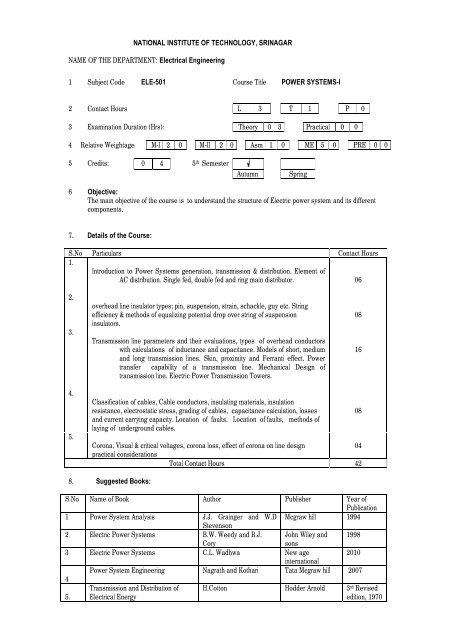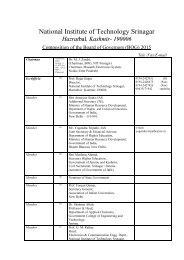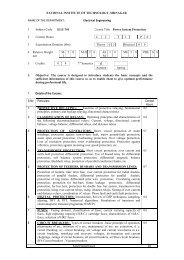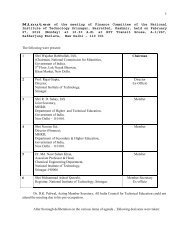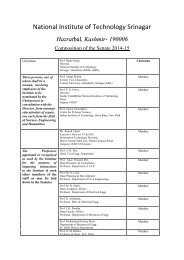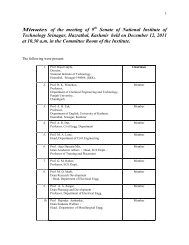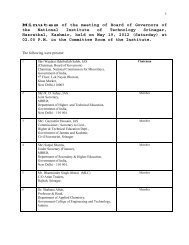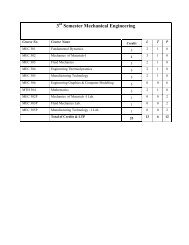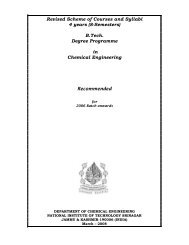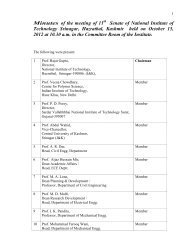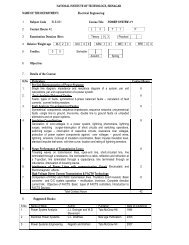Syllabus (5th Semester) - NIT Srinagar
Syllabus (5th Semester) - NIT Srinagar
Syllabus (5th Semester) - NIT Srinagar
You also want an ePaper? Increase the reach of your titles
YUMPU automatically turns print PDFs into web optimized ePapers that Google loves.
NATIONAL INSTITUTE OF TECHNOLOGY, SRINAGARNAME OF THE DEPARTMENT: Electrical Engineering1 Subject Code ELE-501 Course Title POWER SYSTEMS-I2 Contact Hours L 3 T 1 P 03 Examination Duration (Hrs): Theory 0 3 Practical 0 04 Relative Weightage M-I 2 0 M-II 2 0 Asm 1 0 ME 5 0 PRE 0 05 Credits: 0 4 5 th <strong>Semester</strong>AutumnSpring6 Objective:The main objective of the course is to understand the structure of Electric power system and its differentcomponents.7. Details of the Course:S.No Particulars Contact Hours1.Introduction to Power Systems generation, transmission & distribution. Element ofAC distribution. Single fed, double fed and ring main distributor. 062.3.overhead line insulator types; pin, suspension, strain, schackle, guy etc. Stringefficiency & methods of equalizing potential drop over string of suspensioninsulators.Transmission line parameters and their evaluations, types of overhead conductorswith calculations of inductance and capacitance. Models of short, mediumand long transmission lines. Skin, proximity and Ferranti effect. Powertransfer capability of a transmission line. Mechanical Design oftransmission line. Electric Power Transmission Towers.08164.5.Classification of cables, Cable conductors, insulating materials, insulationresistance, electrostatic stress, grading of cables, capacitance calculation, lossesand current carrying capacity. Location of faults. Location of faults, methods oflaying of underground cables.Corona, Visual & critical voltages, corona loss, effect of corona on line design04practical considerationsTotal Contact Hours 42088. Suggested Books:S.No Name of Book Author Publisher Year ofPublication1 Power System Analysis J.J. Grainger and W.D Mcgraw hill 1994Stevenson2 Electric Power Systems B.W. Weedy and B.J. John Wiley and 1998Corysons3 Electric Power Systems C.L. Wadhwa New age2010internationalPower System Engineering Nagrath and Kothari Tata Mcgraw hill 200745.Transmission and Distribution ofElectrical EnergyH.Cotton Hodder Arnold 3 rd Revisededition, 1970
NATIONAL INSTITUTE OF TECHNOLOGY, SRINAGARNAME OF THE DEPARTMENT: Electrical Engineering1 Subject Code ELE-502 Course Title ELECTRICAL MACHNINES - II2 Contact Hours L 3 T 1 P 23 Examination Duration (Hrs): Theory 0 3 Practical 0 04 Relative Weightage M-I 2 0 M-II 2 0 Asm 1 0 ME 5 0 PRE 0 05 Credits: 0 5 5 th <strong>Semester</strong>AutumnSpring6 Objective:The objective of the course is to study the various types of conventional and advanced motors ,generators and transformers. It helps to build a strong foundation in an electrical power system.7. Details of the Course:S.No Particulars Contact Hours1. Basic Concepts in A.C. Rotating Electrical MachinesThe rotating magnetic field, Magneto-motive force and flux distribution, Inducedvoltage, Production of torque, Leakage fluxes, losses and efficiency2. Induction Machinesa. Three Phase Induction MotorsPrinciple of operation of an induction motor, Construction, Types, Equivalentcircuit, Torque/speed characteristics, Induction motor tests, Starting, Speedcontrol, Induction generator, Schrage Motor, Circle Diagram, Applications andselectionb. Single-Phase Induction MotorsTypes of 1-phase induction motors, analysis and testing of 1-phase inductionmotors, universal motor3. 1. Synchronous MachinesConstructional features, Types and working principle, windings, Equivalent circuit,voltage regulation and its determination, saturation effect, parallel operation, Twoaxistheory, Salient type machines, steady-state power-angle characteristics,Excitation systems, V-curves, synchronous capacitors, Hunting, synchronousMachine Transients, Analysis of sudden 3-phase short circuit, Transient poweranglecharacteristics.22218Total Contact Hours 428. Suggested Books:S.No Name of Book Author Publisher Year ofPublication1 Electric Machinery by Fitzgerald Kingslay, Umans Tata Mcgraw hill 20022 Electric Machines Nagrath and Kothari Tata Mcgraw hill 20103 Electric Machines Guru Oxford universitypress3 rd edition20004Electrical Machines and Transformers Geroge Mc Pherson John Wiley1990Electric Machinery Fundamentals Chapman Tata Mcgraw hill 20105.6. Electric machinery and Transformers Irving Kosow Pearson 20077. Alternating current machinery Langsdorf Tata Mcgraw hill 2009
NATIONAL INSTITUTE OF TECHNOLOGY, SRINAGARNAME OF THE DEPARTMENT:Electrical Engineering1 Subject Code ELE-502P Course Title ELECTRICAL MACHINESLABORATORY –II2 Contact Hours L 0 T 0 P 23 Examination Duration (Hrs): Theory 0 0 Practical 0 24 Relative Weightage MSLE 2 5 ESLE 2 55 Credits: 0 1 3 rd <strong>Semester</strong>AutumnSpring6 Objective:The objective of the lab is to familiarize the students with the different electric machines, their operationand working.7. Lab. Experiments:S.No Experiments1 To study the different parts of an Induction motor. To determine theequivalent–circuit parameters of a 3 - Induction motor by (i) No load test (ii)Blocked rotor test2 To determine the Torque / speed characteristics of a 3- Induction motor3 To determine the speed characteristics of a schrage motor4 To study the speed control of an Induction motor by pole-changing method5 To determine the speed / Torque characteristics of an AC series motor(Universal motor)6 To determine the equivalent circuit parameters of a 1- Induction motor by (i)No load test (ii) Blocked rotor test8 Study of the construction of a synchronous machine9 To obtain the OCC and SCC of a synchronous machine by Synchronousimpedance method10 To synchronize an alternator with bus bars using bright / dark lump method11 . To find voltage regulation of an alternator by actual loading12 To obtain the V-curves and inverted V-curves of a synchronous motor13 To conduct slip-test on a salient-pole synchronous machine and hencedetermine its direct and quadrature – axis reactances
NATIONAL INSTITUTE OF TECHNOLOGY, SRINAGARNAME OF THE DEPARTMENT: Electrical Engineering1 Subject Code ELE-503 Course Title CONTROL SYSTEM-II2 Contact Hours L 2 T 1 P 23 Examination Duration (Hrs): Theory 0 3 Practical 0 04 Relative Weightage M-I 2 0 M-II 2 0 Asm 1 0 ME 5 0 PRE 0 05 Credits: 0 4 5 th <strong>Semester</strong>6 Objective:AutumnSpringThis course deals with the modern control theory, non linear control and advanced control techniques.The course is organized in such a fashion that the students will develop lot of interest in researchactivity.7. Details of the Course:S.No Particulars Contact Hours1. State variable modeling.Block diagram, transfer function and signal flow graphs in state space2. State variable analysis and design solution of state vector equations, design usingstate – variable feed back. Controllability and observability.3. Digital control system:4.Hardware elements of a digital control system, Z- transform, inverse Z-transform,difference equations, pulse transfer function. Discrete time system analysisNon linear control systems.Linearization of Non-linear control system about and nominal operating point,analysis and design using linearized models5. Advanced control techniques:a) Fuzzy logic controlb) Adaptive controlNeural Network based control8. Suggested Books:Total Contact Hours 44S.No Name of Book Author Publisher Year ofPublication1 State variable methods and digital M. Gopal Tata Mcgraw Hill 2 nd editioncontrol2 Control system engineering Norman .s. Nise John Wiley 20093 Control systems A. Anand Kumar PHI Learning Pvt. 2009LtdFeedback control of dynamic systems Franklin and powel Prentice hall 5 th edition40814100408
NATIONAL INSTITUTE OF TECHNOLOGY, SRINAGARNAME OF THE DEPARTMENT:Electrical Engineering1 Subject Code ELE-503P Course Title CONTROL SYSTEMS & V I LAB.2 Contact Hours L 0 T 0 P 23 Examination Duration (Hrs): Theory 0 0 Practical 0 24 Relative Weightage MSLE 2 5 ESLE 2 55 Credits: 0 1 3 rd <strong>Semester</strong>AutumnSpring6 Objective:The objective of the lab is to make the students understand the applications of control system in day today life.8. Lab. Experiments:S.No Experiments1 To study the performance of Relay control Combination of P, I and D control schemes in a typicalthermal system (Oven).2 To study the torque-speed characteristics of an AC servomotor3 To study the time response of a variety of simulated linear systems4 To study the role of feedback in a DC speed control system5 To study the role of feedback in a DC position control system6 Use of MATLAB / SIMULINK /Control System tool boxes7 To study the role of a combination of P,I and D control actions in a variety of simulated linearsystems8 To study the computer simulation of a number of systems9 System identification using frequency domain techniques10 Lead/ lag compensator design11 Microprocessor based PID control12 Computer control of systems13 Control of stepper motor14 Control system (State Space)`15Fuzzy logic and neural network tool boxes
NATIONAL INSTITUTE OF TECHNOLOGY, SRINAGARNAME OF THE DEPARTMENT:Electrical Engineering1 Subject Code ELE-504 Course Title Computer Aided Simulation ofElectrical Systems2 Contact Hours L 0 T 0 P 33 Examination Duration (Hrs): Theory 0 0 Practical 0 24 Relative Weightage MSLE 2 5 ESLE 2 55 Credits: 0 2 3 rd <strong>Semester</strong>6 Objective:AutumnSpringThe objective of the course is to make students analyze different control systems using MATLAB andSIMULINK tool boxes.9. Lab. Experiments:S.No Experiments1 Use of MATLAB in:1. Analysis of D.C Circuits2. Transient and steady state analysis of a.c/d.c circuits.3. Analysis of control systemsAnalysis of Electric Machines and Transformers2 Use of MATLAB and SIMULINK Tool boxes3 Use of Control System (State Space), Fuzzy Logic & Neural Network Tool Boxes
NATIONAL INSTITUTE OF TECHNOLOGY, SRINAGARNAME OF THE DEPARTMENT: Electrical Engineering1 Subject Code ECE-508 Course Title COMMUNICATION SYSTEMS2 Contact Hours L 2 T 1 P 03 Examination Duration (Hrs): Theory 0 3 Practical 0 04 Relative Weightage M-I 2 0 M-II 2 0 Asm 1 0 ME 5 0 PRE 0 05 Credits: 0 3 5 th <strong>Semester</strong>AutumnSpring6 Objective:The objective of the course is to make students understand the fundamentals of point to pointcommunication link. It also provides design issues in a digital communication and differentcommunication techniques.7. Details of the Course:S.No Particulars Contact Hours1. Spectral analysis of Signals:Fourier series of repetative signals, Fourier transform of non- repetative signals,amplitude spectrum of special signals viz. Pulse train and pulse waveform2. Modulation:AM, DSB/SC, SSB, VSB, Angle modulation, NBFM, WBFM, Diode detector,Frequency discriminator, AM & FM, Transmitter3. Demodulation:4.AM and FM signals, Radio Receivers – AM & FM, (Block diagram)Noise Analysis:Performance of AM & FM Systems, in presence of noise Threshold in AM & FMDemodulations, Pre- emphasis, and De-emphasis, in FM Systems5. Digital Communication:Sampling, Quantization, Quantization noise, Coding, Pulse code Modulation;Differential PCM, ADPCM, Relative advantages and dis-advantages. Deltamodulation. PWM & PPM6. Digital Modulation Techniques:ESK, FSK, PSK, M-FSK, DPSK, GPSK schemes8. Suggested Books:Total Contact Hours 42S.No Name of Book Author Publisher Year ofPublication1 Electronics communication System G. Kennedy Mcgraw hill 2005education (India)Ltd2 Principles of Communication system Taub and Shelling Tata Mcgraw hill 2007education Pvt LtdCommunication system S. Haykins Willey India Pvt Ltd32007081006060804
NATIONAL INSTITUTE OF TECHNOLOGY, SRINAGARNAME OF THE DEPARTMENT: Electrical Engineering1 Subject Code ECE-509 Course Title DIGITAL ELECTRONICS ANDLOGIC DESIGN2 Contact Hours L 3 T 1 P 23 Examination Duration (Hrs): Theory 0 3 Practical 0 04 Relative Weightage M-I 2 0 M-II 2 0 Asm 1 0 ME 5 0 PRE 0 05 Credits: 0 5 5 th <strong>Semester</strong>AutumnSpring6 Objective:The objective of the course is to make students familiar with Digital controls and different componentsused in digital electronics. It provides the review of basic principles, without any prior knowledge of thetopic.7. Details of the Course:S.No Particulars Contact Hours1. Review of Binary, octal and hexadecimal number systems. Various types of codes062. Boolean algebra and Boolean theorems.043. Logic gates and implementation of Boolean functions with various types of logicgates. Circuit equivalence 064.Simplification techniques and minimization by map methods. Tabular method065. Combination logic and arithmetic circuits. Encoders and Decoders, multiplexes &de-multiplexes046. Sequential circuits –state diagrams and state tables, design and analysis of flipflops,registers, counters. Synchronous and asynchronous operation of sequentialcircuits. Analog to digital convertor, digital to analog convertor7. Latches and memory organisation. ROM’s, EPROM’s and RAM’s –Dynamic andstatic8. Introduction to PLA’s 029. IEEE notations 02Total Contact Hours 4208048. Suggested Books:S.No Name of Book Author Publisher Year ofPublication1 Digital logic M. Moris Mano Pearson 19792 Digital principles and applications A.P. Malvino Tata Mcgraw hill 20063 Switching circuits Marcus Prentice hall 1976-02
NATIONAL INSTITUTE OF TECHNOLOGY, SRINAGARNAME OF THE DEPARTMENT:Electrical Engineering1 Subject Code ECE-510P Course Title DIGITAL ELECTRONICS ANDLOGIC DESIGN LAB2 Contact Hours L 0 T 0 P 23 Examination Duration (Hrs): Theory 0 0 Practical 0 24 Relative Weightage MSLE 2 5 ESLE 2 55 Credits: 0 1 3 rd <strong>Semester</strong>AutumnSpring6 Objective:The objective of the lab is to make students familiar with the different digital devices used in digitalelectronics.10. Lab. Experiments:S.No Experiments1 To verify the truth table of following logic gates:AND, OR and NOT.NAND, NOR, XOR and XNOR2 To realize the above gates using discrete active and passive components3 To implement XOR and XNOR using universal logic gates4 To verify DE Morgans law using logic gates5 To implement certain Boolean expressions and check their equality6 To design and realizea) Half adder and verify its truth table.b) Full adder and verify its truth table.c) Half subtractor and verify its truth table.d) Full subtractor and verify its truth table7 To design a multiplexer/ demultiplexer using two input NAND gates8 To design a 4-bit binary to decimal convertor9 To design a modulo 10 counter10 Given the frequency f obtain the waveforms with frequencies f/2, f/5 & f/1011 Design and realize the following flip-flops using logic gates.12 Use PLL asa) RS flip flop b) JK flip flop. c) D flip flop d) T flip flop.a) Frequency multiplier.b) Frequency demodulator13 MINI PROJECT: Design and fabricate a frequency counter clock
NATIONAL INSTITUTE OF TECHNOLOGY, SRINAGARNAME OF THE DEPARTMENT: Electrical Engineering1 Subject Code MTH-503 Course Title MATHEMATICS-V2 Contact Hours L 2 T 1 P 03 Examination Duration (Hrs): Theory 0 3 Practical 0 04 Relative Weightage M-I 2 0 M-II 2 0 Asm 1 0 ME 5 0 PRE 0 05 Credits: 0 3 5 th <strong>Semester</strong>AutumnSpring6 Objective:The main theme of the course is to use Numerical Techniques in Electrical engineeringproblems.7. Details of the Course:S.No Particulars Contact Hours1. Finite Difference:Difference Table and its usage. The difference operators Δ,▼ and the operator E 042. Interpolation:Interpolation with equal intervals, Newton’s advancing difference formula. Newtons’s backwarddifference formula. Interpolation with unequal intervals. Newton’s divided difference formula. 06Lagrange’s interpolation formula3. 2. Central Differences:The central difference operator δ and the overraging operator μ. Relations between theoperators.Gauss forward and backward interpolation formula, Sterlings, Bessel’s, Laplace and 04Everetts formulaeNumerical solution of algebraic and Transcendental Equations:4. Graphic Method, Regula-Fast method, Balzano’s Process of bisection of intervals, Newton-Raphson Method and its geometrical significance5. Numerical Integration:Numerical Integration, General Quadrature Formula, Simpson’s one-third and three-eight rules,Weddles’ rule, Hardy’s rule, Trapezoidal rule.6. Numerical Solution of ordinary differential equations:Numerical solution of ordinary differential equations, Picard’s method. Taylors series method,Euler’s method, Runge-Kutta Method 067. Statistics and Probability:Random experiment, sample space, events, Mutually exclusive events, Classical and Axiomaticapproach (definition) of probability, Dependent and independent events. Addition and multiplicationtheorems on probability, Baye’s theorem on conditional probability.Covariance, Correlation, coefficient of correlation,, lines of Regression, Method of least squares,fitting a straight line and parabola of second degree.Random variable, Moments and moment generating function of discrete and continuous randomvariables Additive and Multiplicative law of mathematical expectationBooks Suggested:Total Contact Hours 42S.No Name of Book Author Publisher Year ofPublication1 Numerical Methods for Scientists and M.K.Jain, S.R.Iyengar & R.K. New age publishers 2005EngineeringJain, Wiley Eastern Ltd2 Mathematical Numerical Analysis S.C. Scarborough CBS Publishers anddistributors3 Introductry methods in Numerical S.S.Sastry PHI learning Pvt Ltd 2009Analysis5 Numerical Methods for Mathematics,Sciences and EnggJ. H. Mathews Prentice hall collegedivision2 nd sub editionJan 19926 Fundamentals of Mathematical Statistics S.C.Gupta and V.K.Kapoor S. chand 20117 Statistical Theory and Methodology inScience and EngineeringBrownlee Krieger publishers co 2 nd edition19848 Introduction to Mathematical Statistics R.E. Walpole 3 rd edition Prentice hall 3 rd sub edition1982060610


